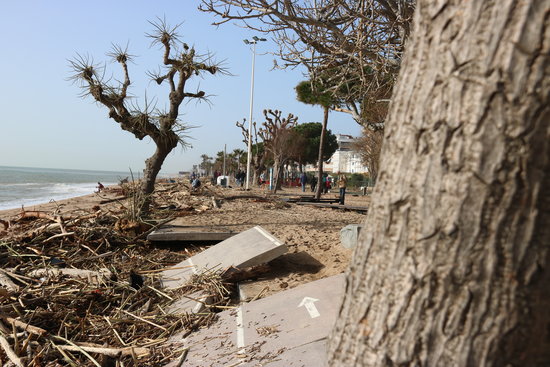Catalonia begins to pick up the pieces from Storm Gloria
Places around the country badly affected by January's severe weather are beginning the expensive process of repairing the damage

At the end of January, Storm Gloria unleashed five continuous days of torrential rain, strong winds and snow on Catalonia, causing widespread damage across the country and even taking the lives of four people.
Since then, the authorities have been assessing the destruction to infrastructure, buildings and the natural landscape, and are now beginning to pick up the pieces and repair the damage, which altogether will end up costing tens of millions of euros.
The seaside town of Malgrat de Mar in the Maresme area, north of Barcelona, for example, said on Thursday that it hopes to have its local beaches, which were largely washed away in the storm, ready for use again by Easter.
With tourism a key economic driver in the area, there is "nervousness" in the local camping sector, for example, about what the summer season will bring in terms of bookings, but also optimism about having new and better beaches once the work is completed.
Another local sector that was hit hard by the storm were small farmers, "some of whom have lost everything and others who will find it difficult to recover," according to representative of the local farmers' union, Miquel Riera.
"Everyone is doing what they can to recover. The water has gone and everything has dried out. Now, it's time to roll up our sleeves and clean up the fields," adds Riera, who also points out that in many of the smallholdings affected were not insured.
€1.8m to restore seafront promenade
Meanwhile, further north up the coast on the Costa Brava, the local authority in Castell-Platja d'Aro said it is spending some 1.8 million euros to repair damage caused by Storm Gloria to its badly damaged seafront promenade.
The work on a 500-meter stretch at the south end of the promenade is due to begin in April, and the local authority hopes to have the seafront ready again by the summer, coinciding with the peak tourist season.
Some of the funds have been provided by the government body, Costes de l'Estat, and as with many of the repair projects now underway, the idea is not only to restore what was damaged but also rebuild against similar episodes in the future.
Local roads still out of action
Yet, it is not only coastal towns that felt the full force of Storm Gloria, as many roads and bridges around the country were also badly damaged by the days of bad weather, as in the case of two towns in the interior of the country, Vilanova de Sau and Brull.
The towns were cut off by the storm when their local roads were left unusable. In the case of Vilanova de Sau the road has now been repaired, but Brull is not so lucky, and the repairs to its road, part of which collapsed in the storm, are proving difficult to complete.
The repairs to the roads will cost some three million euros, according to the Catalan authorities, but what is causing most concern is that it is estimated it will take another three months for the work to be completed.
Apart from the inconvenience to locals, there is concern that the delay in repairing the road will affect tourism, as it is part of a major route to the mountains and the coast, while the arrival of spring brings visitors to the nearby Montseny natural park.
Funding key to the process
As Catalonia attempts to return to normality, a key part of the process will be funding, and on Thursday the authorities in Madrid said that two of the three and a half million euros in state aid for Tarragona in the south will go to repairing damage in the Ebre Delta wetland area.
Meanwhile, the Catalan government said it would spend four million euros on 120 employment plans for the towns and counties most affected by the storm, to offer jobs and training in those areas as part of the process of repairing the damage.